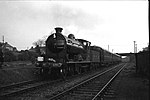Cadder
BishopbriggsCivil parishes of ScotlandForts of the Antonine WallSuburbs in East Dunbartonshire

Cadder (Scottish Gaelic: Coille Dobhair) is a district of the town of Bishopbriggs, East Dunbartonshire, Scotland. It is located 7 km north of Glasgow city centre, 0.5 km south of the River Kelvin, and approximately 1.5 km north-east of Bishopbriggs town centre, sited on the route of the Forth and Clyde Canal. There is a Glasgow council housing scheme of a similar name, generally pronounced Cawder, in the district of Lambhill some 3 miles (5 km) to the south-west along the Canal, which was built in the early 1950s. Similarly, within Cadder, there is Cawder Golf Club, which also uses that original pronunciation.
Excerpt from the Wikipedia article Cadder (License: CC BY-SA 3.0, Authors, Images).Cadder
Geographical coordinates (GPS) Address Nearby Places Show on map
Geographical coordinates (GPS)
| Latitude | Longitude |
|---|---|
| N 55.92 ° | E -4.22 ° |
Address
, Cadder
Scotland, United Kingdom
Open on Google Maps








